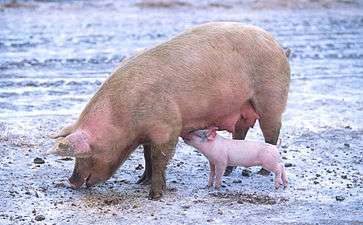Intensive pig farming
Intensive pig farming, also known as pig factory farming is a subset of pig farming and of Industrial animal agriculture, all of which are types of animal husbandry, in which livestock domestic pigs are raised up to slaughter weight. These operations are known as AFO or CAFO in the U.S. In this system of pig production, grower pigs are housed indoors in group-housing or straw-lined sheds, whilst pregnant sows are housed in gestation crates or pens and give birth in farrowing crates.
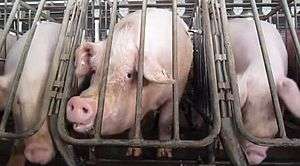
| Agriculture |
|---|
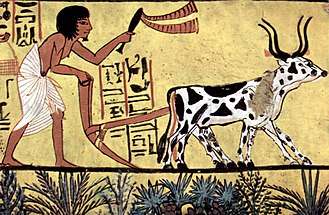 |
|
Categories
|
|
|
The use of gestation crates for pregnant sows has resulted in lower birth production costs; however, this practice has led to more significant animal cruelty. Many of the world's largest producers of pigs (US, China, Mexico) use gestation crates but some nations and nine US states have banned and removed these crates. The European Union has banned the use of gestation crates after the 4th week of pregnancy.[1]
Description
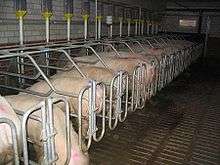
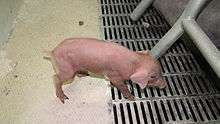
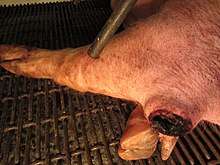
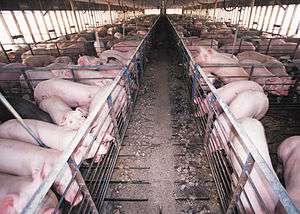
Intensive piggeries are generally large warehouse-like buildings or barns with little exposure to sunlight or the outdoors. Most pigs are officially entitled to less than one square meter of space each.[2] Indoor pig systems allow many more pigs to be monitored than traditional methods, ensuring minimum fatalities, lowered cost, and increased productivity. Buildings are ventilated and their temperature regulated.
Most domestic pig varieties are susceptible to sunburn and heat stress, and all pigs lack sweat glands and cannot cool themselves. Pigs have a limited tolerance to high temperatures and heat stress can lead to death. Maintaining a more specific temperature within the pig-tolerance range also maximizes growth and growth-to-feed ratio. Indoor piggeries have allowed pig farming to be undertaken in countries or areas with unsuitable climate or soil for outdoor pig raising.[3] In an intensive operation, pigs no longer need access to a wallow (mud), which is their natural cooling mechanism. Intensive piggeries control temperature through ventilation or drip water systems.
The way animals are housed in intensive systems varies, and depending on economic viability, dry or open time for sows can sometimes be spent in indoor pens or outdoor pens or pastures.
The pigs begin life in a farrowing or gestation crate, a small pen with a central cage, designed to allow the piglets to feed from their mother, the sow, while preventing her from moving around, crushing her children, and reducing aggression.[4] The crates are so small that the pigs cannot turn around.[5][6]
Artificial insemination is much more common than natural mating, as it allows up to 30-40 female pigs to be impregnated from a single boar.[7] Workers collect the semen by masturbating the boars, then insert it into the sows via a raised catheter known as a pork stork.[8] Boars are still physically used to excite the females prior to insemination, but are prevented from actually mating.[9]
When confirmed pregnant, sows are moved to farrowing crates, with litter, and will spend their time in gestation crates from before farrowing until weaning.[10] Injections with a high availability iron solution often are given, as sow's milk is low in iron. Vitamin D supplements are also given to compensate for the lack of sunlight. As the sows’ bodies become less capable of handling the large litter sizes encouraged by the industry, the frequency of stillborn piglets generally increases with each litter.[11] These high litter sizes have doubled the death rates of sows, and as many as 25%-50% of sow deaths have been caused by prolapse.[12] The cycle of impregnation and confinement is repeated for about 3 to 5 years or until the sow succumbs to her injuries, at which point she is then slaughtered for low-grade meat such as pies, pasties and sausage meat.[13]
10-18% of piglets who are born alive won't make it to weaning age, succumbing to disease, starvation, dehydration, or being accidentally crushed by their trapped mothers.[14][15] This death toll includes the runts of the litter, who are considered economically unviable and killed by staff, typically by blunt trauma to the head.[16][17]
Piglets who survive the first few days of their life are subjected to castration, earmarking, tattooing for litter identification, tail docking, teeth clipping to prevent cannibalism, instability, aggression, and tail biting that is induced by the cramped environment.[18][14][19] Because anesthetic is not legally mandated and often economically unviable, these invasive procedures are usually done without any pain killers.[20] While wild piglets remain with their mothers for around 12 to 14 weeks, farmed piglets are weaned and removed from their mothers at between two and five weeks old.[21][22] They are then placed in sheds, nursery barns or directly to growout barns. While capable of living 10–12 years, most pigs are slaughtered when they are 5–6 months old.[4][23]
Grower pigs are usually housed in alternative indoor housing, such as batch pens. Group pens generally require higher stockmanship skills. Such pens will usually not contain straw or other material. Alternatively, a straw-lined shed may house a larger group in age groups. Larger swine operations use slotted floors for waste removal, and deliver bulk feed into feeders in each pen; feed is available ad libitum.
Pigs are naturally omnivorous and are generally fed a combination of grains and protein sources (soybeans, or meat and bone meal). Larger intensive pig farms may be surrounded by farmland where feed-grain crops are grown. Consequently, piggeries are reliant on the grains industry. Pig feed may be bought packaged, in bulk or mixed on-site. The intensive piggery system, where pigs are confined in individual stalls, allows each pig to be allotted a portion of feed. The individual feeding system also facilitates individual medication of pigs through feed. This has more significance to intensive farming methods, as the proximity to other animals enables diseases to spread more rapidly. To prevent disease spreading and encourage growth, drug programs such as vitamins and antibiotics are administered preemptively.
Indoor systems allow for the easy collection of waste. In an indoor intensive pig farm, manure can be managed through a lagoon system or other waste-management system. However, waste smell remains a problem which is difficult to manage.[24] Pigs in the wild or on open farmland are naturally clean animals.[14]
Popularity
In the UK there are around 11,000 pig farms. Approximately 1,400 of these units house more than 1,000 pigs and contain about 85% of the total UK pig population.[25][26] Because of this, the vast majority of the pork products sold in the UK come from intensive farms.[27] There were around 50,000 pig farms in Australia in the 1960s.[28] Today, there are fewer than 1,400, and yet the total number of pigs bred and slaughtered for food has increased.[29] As of 2015, 49 farms housed 60% of the country's total pig population.[30][31]
Environmental impacts
(NRCS_Photo_Gallery).tif.png)
Intensive pig farming adversely affects the surrounding environment.
Regulation
Many countries have introduced laws to regulate treatment of intensively farmed pigs. However, there is no legal definition for free-range pigs, so retailers can label pork products as free-range without having to adhere to any standards or guidelines.[32] Only 3% of UK pigs spend their entire lives outdoors.[33]
EU
As of 2016, The European Union legislation has required that pigs be given environmental enrichment, specifically they must have permanent access to a sufficient quantity of material to enable proper investigation and manipulation activities.[34]
Under the legislation tail docking may only be used as a last resort. The law provides that farmers must first take measures to improve the pigs’ conditions and, only where these have failed to prevent tail biting, may they tail dock.[35]
United States
Nine states have banned the use of gestation crates, with Rhode Island being the most recent as of July 2012.[36]
Discharge from CAFOs is regulated by the federal Environmental Protection Agency (EPA). In 2003, the EPA revised the Clean Water Act to include permitting requirements and effluent (discharge) limitations for CAFOs. In 2008, final AFO/CAFO regulation revised portions of it under EPA's National Point Discharge Elimination System (NPDES) permitting program.[37]
The federal Humane Slaughter Act requires pigs to be stunned before slaughter, although compliance and enforcement is questioned. There is concern from animal liberation/welfare groups that the laws have not resulted in a prevention of animal suffering and that there are "repeated violations of the Humane Slaughter Act at dozens of slaughterhouses".[38]
Criticism
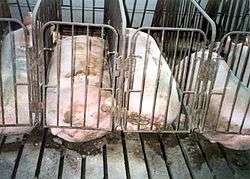
Dispute regarding farming methods
Intensive piggeries are presently being progressively increasingly criticized in preference of free range systems. Such systems usually refer not to a group-pen or shedding system, but to outdoor farming systems. Those that support outdoor systems usually do so on the grounds that they are more animal friendly and allow pigs to experience natural activities (e.g., wallowing in mud, relating to young, rooting soil). Outdoor systems are usually less economically productive due to increased space requirements and higher morbidity, (though, when dealing with the killing of piglets and other groups of swine, the methods are the same.) They also have a range of environmental impacts, such as denitrification of soil[39][40] and erosion. Outdoor pig farming may also have welfare implications, for example, pigs kept outside may get sunburnt and are more susceptible to heat stress than in indoor systems, where air conditioning or similar can be used.[41][42] Outdoor pig farming may also increase the incidence of worms and parasites in pigs.[43][44] Management of these problems depends on local conditions, such as geography, climate, and the availability of skilled staff.
Transition of an indoor production system to an outdoor system may present obstacles. Some breeds of pig commonly used in intensive farming have been selectively bred to suit intensive conditions. Lean pink-pigmented pigs are unsuited for outdoor agriculture, as they suffer sunburn and heat stress. In certain environmental conditions – for example, a temperate climate – outdoor pig farming of these breeds is possible. However, there are many other breeds of pig suited to outdoor rearing, as they have been used in this way for centuries, such as Gloucester Old Spot and Oxford Forest. Following the UK ban of sow stalls, the British Pig Executive indicates that the pig farming industry in the UK has declined.[45] The increase in production costs[46] has led to British pig-products being more expensive than those from other countries, leading to increased imports and the need to position UK pork as a product deserving a price premium.
In 1997, Grampian Country Foods, then the UK's largest pig producer, pointed out that pigmeat production costs in the UK were 44 p/kg higher than on the continent. Grampian stated that only 2 p/kg of this was due to the ban on stalls; the majority of the extra costs resulted from the then strength of sterling and the fact that at that time meat and bone meal had been banned in the UK but not on the continent. A study by the Meat and Livestock Commission in 1999, the year that the gestation crate ban came into force, found that moving from gestation crates, to group housing added just 1.6 pence to the cost of producing 1 kg of pigmeat. French and Dutch studies show that even in the higher welfare group housing systems – ones giving more space and straw – a kg of pigmeat costs less than 2 pence more to produce than in gestation crates.[35]
Sow breeding systems
Organized campaigns by animal activists have focused on the use of the gestation crate, such as the 'gestation crate' and farrowing crate. The gestation crate has now been banned in the UK, certain US states, and other European countries, although it remains part of pig production in much of the US and European Union.
The sows selected for breeding will be confined in a gestation crate. Hogs (males) are kept confined in caged crates of the same size for the duration of their lives in order to have their sperm repeatedly extracted by workers. In an intensive system, the sow will be placed in a crate prior to insemination and will stay there for at least the start of her pregnancy, depending on each country's laws and local regulations. The typical length of the sow's pregnancy is 3 months, 3 weeks, and 3 days. In certain cases, sows may spend this time in the crate. However, a variety of farming systems are used and the time in the crate may vary from 4 weeks to the whole pregnancy.
There is also current controversy and criticism of 'farrowing crates'. A farrowing crate houses the sow in one section and her piglets in another. It allows the sow to lie down and roll over to feed her piglets, but keeps her piglets in a separate section. This prevents the large sow from sitting on her piglets and killing them, which is quite common where the sow is not separated from the piglets.[47] Sows are also prevented from being able to move other than between standing and lying. Some models of farrowing crates may allow more space than others, and allow greater interaction between sow and young. Well-designed farrowing pens in which the sow has ample space can be just as effective as crates in preventing piglet mortality.[35] Some crates may also be designed with cost-effectiveness or efficiency in mind and therefore be smaller.
Authoritative industry data indicate that moving from sow stalls to group housing added 2 pence to the cost of producing 1 kg. of pigmeat.[35]
Many English fattening pigs are kept in barren conditions and are routinely tail docked. Since 2003 EU legislation has required pigs to be given environmental enrichment and has banned routine tail docking. However, 80% of UK pigs are tail docked.[35]
In 2015, use of sow crates was made illegal on New Zealand pig farms.[48]
Effects on traditional rural communities
Common criticism of intensive piggeries is that they represent a corporatization of the traditional rural lifestyle. Critics feel the rise of intensive piggeries has largely replaced family farming. Between 1982 and 1987 some 21% of Iowa hog farmers went out of business. By 1992, another 12% had gone out of business. In large part, this is because intensive piggeries are more economical than outdoor systems, pen systems, or the sty. In many pork-producing countries (e.g., United States, Canada, Australia, Denmark) the use of intensive piggeries has led to market rationalization and concentration. The New York Times reported that keeping pigs and other animals in "unnaturally overcrowded" environments poses considerable health risks for workers, neighbors, and consumers.[49]
Waste management and public health concerns
Contaminants from animal wastes can enter the environment through pathways such as through leakage of poorly constructed manure lagoons or during major precipitation events resulting in either overflow of lagoons and runoff from recent applications of waste to farm fields, or atmospheric deposition followed by dry or wet fallout. Runoff can leach through permeable soils to vulnerable aquifers that tap ground water sources for human consumption. Runoff of manure can also find its way into surface water such as lakes, streams, and ponds. An example of weather induced runoff having been recently reported in the wake of Hurricane Matthew.[50]
Many contaminants are present in livestock wastes, including nutrients, pathogens, veterinary pharmaceuticals and naturally excreted hormones. Improper disposal of animal carcasses and abandoned livestock facilities can also contribute to water quality problems in surrounding areas of CAFOs.
Exposure to waterborne contaminants can result from both recreational use of affected surface water and from ingestion of drinking water derived from either contaminated surface water or ground water. High-Risk populations are generally the very young, the elderly, pregnant women, and immunocompromised individuals. Dermal contact may cause skin, eye, or ear infections. Drinking water exposures to pathogens could occur in vulnerable private wells.[51]
At Varkensproefcentrum Sterksel in the Netherlands, a pig farm has been created that reuses its waste streams. CO² and ammonia from the pig manure are reused to grow algae which in turn are used to feed the pigs.[52]
Another method to reduce the effect on the environment is to switch to other breeds of pig. The enviropig is a genetically modified type of pig with the capability to digest plant phosphorus more efficiently than ordinary pigs, though the enviropig program ended in 2012 and did not reach commercial distribution.
Nutrient-rich runoff from CAFO's can contribute to Algal blooms in rivers, lakes and seas. The 2009 Harmful Algal Bloom event off the coast of Brittany, France was attributed to runoff from an intensive pig farm.[53]
North Carolina
As of 2010, North Carolina housed approximately ten million hogs, most of which are located in the eastern half of the state in industrialized CAFOs or Confined Animal Feeding Operations. This was not the case twenty years ago. The initial horizontal integration and the vertical integration that arose in this industry resulted in numerous issues, including issues of environmental disparity, loss of work, pollution, animal rights, and overall general public health. The most remarkable example of swine CAFO monopoly is found in the United States, where in 2001, 50 producers had control over 70% of total pork production. In 2001, the biggest CAFO had just over 710,000 sows.[54]
Originally, Murphy Family Farms horizontally integrated the North Carolina system. They laid the groundwork for the industry to be vertically integrated. Today the hog industry in North Carolina is led by Smithfield Foods, which has expanded into both nationwide and international production.[55]
The environmental justice problems in North Carolina's agroindustrialization of swine production seem to stem from the history of the coastal region's economy, which has relied heavily on black and low-income populations to supply the necessary agricultural labor. The industry's shift from family-owned hog farms to factory hogging has contributed to the frequent targeting of these areas.[56]
This swine production and pollution that accompanies factory hogging is concentrated in the parts of North Carolina that have the highest disease rates, the least access to medical care, and the greatest need for positive education and economic development.[57] Since hog production has become consolidated in the coastal region of N.C., the high water tables and low-lying flood plains have increased the risk and impact of hog farm pollution. A swine CAFO is made up of three parts: the hog house, the “lagoon,” and the “spray field.” Waste disposal techniques used by small-scale traditional hog farms, like using waste as fertilizer for commercially viable crops, were adopted and expanded for use by CAFOs. Lagoons are supposed to be protected with an impermeable liner, but some do not work properly. This can cause environmental damage, as seen in 1995 when a lagoon burst in North Carolina. This lagoon released 25 million gallons of noxious sludge into North Carolina's New River and killed approximately eight to ten million fish.[58]
The toxins emitted by the swine CAFOs can produce a variety of symptoms and illnesses ranging from respiratory disorders, headaches, and shortness of breath to hydrogen sulfide poisoning, bronchitis, and asthma. The potential for spray field runoff or lagoon leakage puts nearby residents in danger of contaminated drinking water, which can lead to diseases like samonellosis, giardiasis, Chlamydia, meningitis, cryptosporidiosis, worms, and influenza.[59]
Denmark
Slaughterhouses and veterinarians are obliged to report pigs with injuries to the Ministry of Food, Agriculture and Fisheries, which forwards cases to the police. There were relatively few cases before 2006, but by 2008-9 there were about 300 per year.[60] When there are visible injuries, it represents not only a problem in animal welfare but also the farmers economy because parts or occasionally the entire carcass has to be discarded.[60] From 2006 to 2009 the number of pigs with injuries caused by hard objects, such as planks or chains received by slaughterhouses rose significantly. It was possibly related to a system introduced in 2006, which rewards "the rushed loading of animals onto vehicles", as well as a sharp increase in uneducated Eastern European farm workers unaware of Danish laws.[61][60]
Gestation crates were sometimes used on some Danish farms to restrict the movement of sows during pregnancy, as documented by British celebrity chef Jamie Oliver in a television programme for the UK's Channel 4 in 2009.[62] In other fields, such as bathing facilities for the pigs and floor material Danish requirements were higher than in the UK.[62] As of 2008 the practice was already prohibited for pigs exported to the UK.[63] The use of gestation crates became illegal in Denmark (as part of the EU) in 2013.[64][65][66]
New Zealand
According to Scoop, in 2009 the New Zealand pork industry was "dealt a shameful public relations slap-in-the-face after its former celebrity kingpin, Mike King, outed their farming practices as 'brutal', 'callous' and 'evil'" on a May episode of New Zealand television show Sunday. King condemned the "appalling treatment" of factory farmed pigs. King observed conditions inside a New Zealand piggery, and saw a dead female pig inside a gestation crate, lame and crippled pigs and others that could barely stand, pigs either extremely depressed or highly distressed, pigs with scars and injuries, and a lack of clean drinking water and food.
Sow crate farming should be illegal and we should outlaw it right now. It is absolutely disgusting and I am sorry that I was part of it
— Mike King, 2009[67]
References
- Werblow, Steve (27 January 2014). "Gestation crates: News from the front lines". Pork Network. Retrieved 3 October 2015.
- "Key figures for pig accommodation in England – legislative requirements" (PDF). AHDB Pork. Archived from the original (PDF) on 3 June 2019.
- "Australian pork page on Pig welfare". Australainpork.com.au. Archived from the original on 9 October 2007. Retrieved 28 July 2017.
- Cutler, R; Holyoake, P (2007). "The Structure and Dynamics of the Pig Meat Industry, prepared for Department of Agriculture, Fisheries and Forestry" (PDF).
- "Opinion on Free Farrowing Systems" (PDF). Farm Animal Welfare Committee. Archived from the original (PDF) on 3 April 2019.
- Admin (2016-01-06). "Farrowing Fact Sheet". Viva! - The Vegan Charity. Retrieved 2019-06-03.
- "Pigs | The Vegetarian Society". Vegetarian Society. Retrieved 2019-06-03.
- "Inseminating sows". Qld Government Department of Agriculture and Fisheries.
- "Collecting semen from boars". Qld Government Department of Agriculture and Fisheries.
- "Pigs". Australian Pork Limited. 2017.
- "Fact Sheet – 'Reproductive Health'" (PDF). australianpork.com.au. Australian Pork Limited. 2012.
- Greenaway, Twilight (2018-10-01). "'We've bred them to their limit': death rates surge for female pigs in the US". the Guardian. Retrieved 2018-11-17.
- Mitchell, Angella (2002). Animal FAQs: An Encyclopedia of Animal Abuse. Troubador Publishing. p. 133. ISBN 1899293728.
- "Industry Focus". australianpork.com.au. Australian Pork Limited.
- "Pre-weaning mortality". pigprogress.net. Pig Progress.
- Model code of practice for the welfare of animals: Pigs, Primary Industries Report Series third edition. publish.csiro.au. 2008.
- "Best of British? The Pig Industry Exposed" (PDF). Animal Aid.
- "The risks associated with tail biting in pigs and possible means to reduce the need for tail docking considering the different housing and husbandry systems - Scientific Opinion of the Panel on Animal Health and Welfare". EFSA Journal. 5 (12): 611. 2007. doi:10.2903/j.efsa.2007.611.
- Cutler, R; Holyoake, P (2007). "The Structure and Dynamics of the Pig Meat Industry, prepared for Department of Agriculture, Fisheries and Forestry" (PDF). agriculture.gov.au.
- "Video Gallery". aussiepigs.com.
- "Revisiting Weaning Age Trends, Dynamics". Nationalhogfarmer.com. 15 October 2005. Retrieved 28 July 2017.
- "Pig welfare". ciwf.org.uk. Retrieved 2019-06-03.
- "Pigs: Production Cycle". Australian Pork.
- G. Galvin; K.D. Casey S.A. Lowe; N.A. Hudson; M.A. Atzeni; E.J. McGahan (12 October 2003). "Spatial Variability Of Odor Emissions From Anaerobic Piggery Lagoons In Queensland". Air Pollution from Agricultural Operations III, Proceedings of the 12–15 October 2003 Conference (Research Triangle Park, North Carolina USA). St. Joseph, MI: American Society of Agricultural and Biological Engineers. pp. 292–302. 701P1403. Archived from the original on 28 September 2007. Retrieved 30 April 2008.
- "Pig Holdings in the UK". pork.ahdb.org.uk. Retrieved 2019-06-03.
- "Reduction in number of UK pig farms". pork.ahdb.org.uk. Retrieved 2019-06-03.
- Justin (2016-08-16). "MAJOR INVESTIGATION INTO UK PIG FARMING REVEALS 90% ARE FACTORY FARMED". Viva! - The Vegan Charity. Retrieved 2019-06-03.
- Cutler, R; Holyoake, P (2007). "The Structure and Dynamics of the Pig Meat Industry, prepared for Department of Agriculture, Fisheries and Forestry" (PDF).
- "Where have all the pig farmers gone". ABC Rural. 5 May 2014.
- "Pigs for meat (pork)". AgriFutures, Australia.
- "Australian Pig Annual 2010-2011" (PDF). Australian Pork Limited.
- "What's Wrong with High-Welfare Animal Products?" (PDF). Animal Aid.
- "Pig farming - Pig welfare - Free range pork". rspca.org.uk. Retrieved 2019-06-03.
- "COMMISSION RECOMMENDATION (EU) 2016/336". EUR-Lex.europa.eu. Retrieved 11 October 2017.
- "Species: pigs - Compassion in World Farming". Ciwf.org.uk. Retrieved 28 July 2017.
- Marcelo, Philip. New R.I. law bans cutting dairy-cow tails, raising pigs and calves in crates Providence Journal, June 21, 2012. Accessed July 31, 2012.
- "Archived copy" (PDF). Archived from the original (PDF) on 2009-05-09. Retrieved 2011-04-09.CS1 maint: archived copy as title (link)
- "Animal Welfare Institute Quarterly – Humane Slaughter Act Resolution Introduced". Awionline.org. Archived from the original on 3 March 2016. Retrieved 28 July 2017.
- "The fate of nitrogen in outdoor pig production" (PDF). Edpsciences.org. Archived from the original (PDF) on 31 August 2004. Retrieved 28 July 2017.
- "Archived copy" (PDF). Archived from the original (PDF) on 2008-06-25. Retrieved 2008-12-04.CS1 maint: archived copy as title (link)
- "Managing Heat Stress in Outdoor pigs". Depts.ttu.edu. Archived from the original on 6 July 2012. Retrieved 28 July 2017.
- "Heat stress index chart for swine producers". Thepigsite.com. Archived from the original on 4 February 2013. Retrieved 28 July 2017.
- Roepstorff A, Murrell KD (May 1997). "Transmission dynamics of helminth parasites of pigs on continuous pasture: Ascaris suum and Trichuris suis". Int. J. Parasitol. 27 (5): 563–72. doi:10.1016/S0020-7519(97)00022-2. PMID 9193950.
- "Management Control and Prevention - Managing Pig Health and Treating Pig Dieases on ThePigSite.com". The Pig Site. Retrieved 28 July 2017.
- "British Pig Executive market update September 2005" (PDF). Bpex.org. Archived from the original (PDF) on 27 February 2008. Retrieved 28 July 2017.
- "Another Move Away from Pork Crates," Archived 2012-07-25 at the Wayback Machine Farm Futures, May 8, 2012.
- “Piglet Losses,” University of Illinois Extension, November 5, 2003.
- "Sow crates to be phased out by 2015". The New Zealand Herald. 1 December 2010. Retrieved 4 October 2011.
- Kakutani, Michiko (20 November 2009). "You Know That Chicken Is Chicken, Right?". The New York Times. Retrieved 28 July 2017 – via NYTimes.com.
- Fritz, Arelis R. Hernández, Angela; Mooney, Chris; Fritz, Arelis R. Hernández, Angela; Mooney, Chris (16 October 2016). "Factory farming practices are under scrutiny again in N.C. after disastrous hurricane floods". The Washington Post. Retrieved 28 July 2017.
- Burkholder JoAnn; Bob Libra, Peter Weyer, Susan Heathcote, Dana Kolpin, Peter S. Thorne, Michael Wichman Impacts of Waste from Concentrated Animal Feeding Operations on Water Quality. Environ Health Perspectives. (2007) 115:308–312.
- "442 -". Innovatienetwek.onlinetouch.nl. Retrieved 28 July 2017.
- Chrisafis, Angelique. "Lethal algae take over beaches in northern France". The Guardian. Retrieved October 10, 2013.
- "Swine production: a global perspective". En.engormix.com. Retrieved 28 July 2017.
- Ladd, Anthony; Edwards, Bob (2002). "Corporate Swine, Capitalist Pigs: A Decade of Environmental Injustice in North Carolina". Social Justice. 29 (3): 26–46.
- Wimberley, Ronald C., Morris, Libbly V. (1997). The Southern Black Belt : A National Perspective. Lexington: University of Kentucky.CS1 maint: multiple names: authors list (link)
- Raine J. Environmental Justice Issues of the North Carolina Swine Industry [Masters thesis]. Durham, NC:Duke University, Nicholas School of the Environment, 1998.
- Orlando, Laura. McFarms Go Wild, Dollars and Sense, July/August 1998, cited in Scully, Matthew. Dominion, St. Martin's Griffin, p. 257.
- Donham K. (1998). "The impact of industrial swine production on human health". In Thu K, Durrenberger E (eds.). Pigs, Profits, and Rural Communities. Albany, NY: State University of New York Press. pp. 73–83.
- Andreas Lindquist (26 July 2010). Danske svin bliver banket gule og blå. Politiken. Retrieved 31 May 2016
- "Alleged Increase in Pig Cruelty". The Pig Site. Retrieved 28 July 2017.
- "Response to 'Jamie Saves Our Bacon'". Archived from the original on May 4, 2009. Retrieved 2009-12-19.CS1 maint: BOT: original-url status unknown (link). Danish Bacon and Meat Council, January 2009.
- Christian Coff, David Barling, Michiel Korthals, Thorkild Nielsen, Ethical Traceability and Communicating Food, pp.90–91, Springer, 2008 ISBN 1-4020-8523-0.
- Jacky Turner. Animal Breeding, Welfare and Society. Earthscan, London. ISBN 978-1844075898
- Humane Society International/Canada. Ban Gestation Crates. Retrieved 31 May 2016
- Anima (25 October 2012). Livet i fikseringsboksen. Retrieved 31 May 2016
- "Mike King Condemns NZ Pig Cruelty - Scoop News". Scoop.co.nz. Retrieved 28 July 2017.
External links
| Wikiquote has quotations related to: Intensive pig farming |
- US Government regulation
- CAFO Hearing 9-6-2007, Written Statement of Commissioner Blackham National Association of State Departments of Agriculture, USA – contains history of CAFO Regulations
- Animal Feeding Operations (AFOs) - Permitting Program, EPA's CAFO Industry Regulation
- North Carolina State Government Study on Ammonia Concentration in the Air
- Proponent, neutral, and industry-related
- The Pig Site – industry support site with feature articles and news, with an emphasis on intensive farming practices
- Purdue University food science extension
- Key industries: Hog farming in North Carolina LEARN NC, a program of the UNC School of Education, 2013
- Criticism of intensive pig farming
- lovepigs.org.nz – the New Zealand group SAFE campaign to end intensive pig farming.
- SaveBabe.com Animals Australia's campaign to end pig factory farming featuring James Cromwell
- Swine Production: A Global Perspective 2/7/2007 JOHN R. MOORE - Alltech Inc.
- Pig Farming Compassion in World Farming, UK
- pork Factory farming.com
